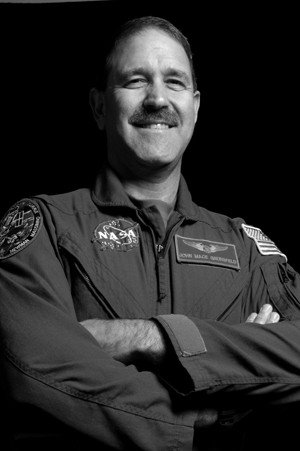|
||
      |
Features ::
Glimpses
John M. Grunsfeld, SM’84, PhD’88, has spent more than 45 days in space. Of that, he logged 37 hours and 32 minutes outside the spacecraft on five space walks, or extravehicular activity (EVA) in NASA parlance. As the Hubble Space Telescope’s top repair and maintenance expert, Grunsfeld has helped reinvent the instrument twice—in 1997 and 2002—on missions that installed new equipment such as spectrographs and a digital camera. “The great advantage of having an observatory on a mountaintop is you can drive up there in a big truck with a new instrument, put it on the back of the telescope, and suddenly it’s a new telescope,” Grunsfeld says. “Well, with the Hubble, we have to use the space shuttle.” In 2008 Grunsfeld will serve as the EVA lead for Hubble’s fifth, and possibly final, servicing mission: “Never say never,” he says.

Just another day at work: Space flight is never routine. The chance of losing a crew on one of these missions is about one in 70. Sitting on a launchpad on top of four-and-a-half million pounds of explosive fuel is a very dangerous thing to do. Launching from the surface of the earth to orbit—going from a standstill to 17,500 miles an hour in eight-and-a-half minutes—is a very violent event. But you kind of put that in that little box and leave it there. I’ve never really experienced gripping fear. A little bit of butterflies.
Hubble’s scientific impact: The Hubble is this incredible discovery machine—almost indisputably the most productive scientific instrument ever created by humans. From 1993 to the present the scientific output has been unbelievable. Are black holes for real? Sure enough, black holes are for real. How old is the universe? That’s a fundamental human thing to want to know. Well, it’s 13.7 plus or minus .1 billion years old. We know that now.
Expanded consciousness: The expectation was that as the universe expands, it should slow down because gravity is pulling on it. The big philosophical question has always been: Will it stop? Will there be a Big Crunch someday? Philosophically that’s kind of attractive. People like closure. It turns out that Hubble discovered the universe isn’t just expanding—it’s accelerating. Nobody really expected that, and nobody knows why. But you can compute how much energy is contained in that pressure that’s causing it to expand. Lo and behold, it accounts for almost three quarters of the entire energy content of the universe—and we have no clue what it is. Well, you might say that’s a pretty big embarrassment for physics. Or you might say, wow, that’s a really cool opportunity for physics. We don’t have a clue what 75 percent of the universe is made out of. And that’s where we are now.
Space flight as transformative experience: For me it was a more of a realization that I finally found a place where I feel at home. This is where I belong: in space. It was a disappointment to have to come home, even though I wanted to see my family and friends. I felt a real sense of joy and peacefulness that I rarely feel on Planet Earth.
How’s the view? The unsettling part is you see the tremendous environmental damage that we’ve inflicted on the planet—everywhere you look. You see clear cutting and fires burning in forests all around the planet: huge plumes of brown smoke coming off of cities, extending across whole oceans, from the Asian continent to North America. Open-pit copper mines in South America that are such a staggering size, they’re visible with the naked eye from space. Contrails from jets crisscrossing all around the earth. It almost looks like the earth has some kind of disease.
Biological challenges during space flight: Gravity and exercise play a big role in transporting solids through your system. In space you’re in free fall, so that doesn’t happen. You have to set aside about 30 to 40 minutes. You get better at it with time, but for the first week or so, you have to plan ahead. It’s another management problem. And of course, you don’t want any of that stuff floating around the cabin.